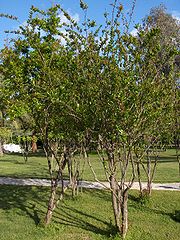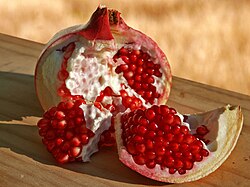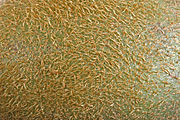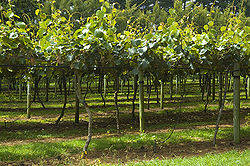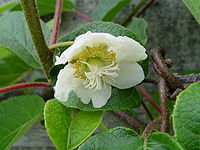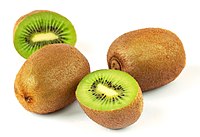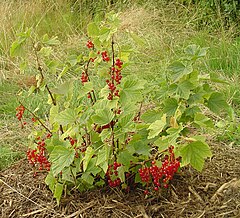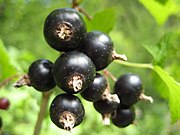The pomegranate (Punica granatum) is a fruit-bearing deciduous shrub or small tree growing to between five and eight metres tall. The pomegranate is native to the region from Iran to the Himalayas in northern India and has been cultivated and naturalized over the whole Mediterranean region and the Caucasus since ancient times. It is widely cultivated throughout Afghanistan, Algeria, Armenia, Azerbaijan, Iran, India, Pakistan, Syria, Turkey, the drier parts of southeast Asia, Peninsular Malaysia, the East Indies, and tropical Africa[1]. Introduced into Latin America and California by Spanish settlers in 1769, pomegranate is now cultivated in parts of California and Arizona for juice production.[2]
In the Northern Hemisphere, the fruit is typically in season from September to January.[3] In the Southern Hemisphere, it is in season from March to May.
Foliage and fruit

The leaves are opposite or sub-opposite, glossy, narrow oblong, entire, 3–7 cm long and 2 cm broad. The flowers are bright red, 3 cm in diameter, with four to five petals (often more on cultivated plants). The fruit is between a lemon and a grapefruit in size, 5–12 cm in diameter with a rounded hexagonal shape, and has thick reddish skin and around 600 seeds.[4] The seeds and surrounding pulp, ranging in color from white to deep red, called arils, are edible; indeed, the fruit of the pomegranate is a berry. There are some cultivars which have been introduced that have a range of pulp colors such as purple.
Punica granatum nana is a dwarf variety of P. granatum popularly used as Bonsai trees and as a patio plant. The only other species in the genus Punica is the Socotran pomegranate (Punica protopunica), which is endemic to the island of Socotra. It differs in having pink (not red) flowers and smaller, less sweet fruit. Pomegranates are drought tolerant, and can be grown in dry areas with either a Mediterranean winter rainfall climate or in summer rainfall climates. In wetter areas, they are prone to root decay from fungal diseases. They are tolerant of moderate frost, down to about −10°C (14°F).
Etymology
| Pomegranate, aril only Nutritional value per 100 g (3.5 oz) | ||||||||||||||||||||||||||||||||||||
|---|---|---|---|---|---|---|---|---|---|---|---|---|---|---|---|---|---|---|---|---|---|---|---|---|---|---|---|---|---|---|---|---|---|---|---|---|
| Energy 70 kcal 290 kJ | ||||||||||||||||||||||||||||||||||||
| ||||||||||||||||||||||||||||||||||||
| Percentages are relative to US recommendations for adults. Source: USDA Nutrient database | ||||||||||||||||||||||||||||||||||||
The name "pomegranate" derives from Latin pomum ("apple") and granatus ("seeded"). This has influenced the common name for pomegranate in many languages (e.g., German Granatapfel, seeded apple). The genus name Punica is named for the Phoenicians, who were active in broadening its cultivation, partly for religious reasons. In classical Latin, where "malum" was broadly applied to many apple-like fruits, the pomegranate's name was malum punicum or malum granatum, the latter giving rise to the Italian name melograno, or less commonly melagrana.
A widespread root for "pomegranate" comes from the Ancient Egyptian rmn, from which derive the Hebrew rimmôn, and Arabic rummân. This root was given by Arabs to other languages, including Portuguese (romã)[5], Kabyle rrumman and Maltese "rummien". The pomegranate ('rimmôn') is mentioned in the Bible as one of the seven fruits/plants that Israel was blessed with, and in Hebrew, 'rimmôn' is also the name of the weapon now called the grenade. According to Webster's New Spanish-English Dictionary, "granada," the Spanish word for "pomegranate," could also mean "grenade." According to the OED, the word "grenade" originated about 1532 from the French name for the pomegranate, la grenade. La grenade also gives us the word grenadine, the name of a kind of fruit syrup, originally made from pomegranates, which is widely used as a cordial and in cocktails.
Origin, cultivation and uses
The pomegranate originated in Persia and has been cultivated in Georgia, Armenia and the Mediterranean region for several millennia.[6]
In Georgia, and Armenia to the east of the Black Sea, there are wild pomegranate groves outside of ancient abandoned settlements. The cultivation of the pomegranate has a long history in Armenia, where decayed remains of pomegranates dating back to 1000 BC have been found. [7]
Carbonized exocarp of the fruit has been identified in Early Bronze Age levels of Jericho, as well as Late Bronze Age levels of Hala Sultan Tekke on Cyprus and Tiryns[citation needed]. A large, dry pomegranate was found in the tomb of Djehuty, the butler of Queen Hatshepsut; Mesopotamian cuneiform records mention pomegranates from the mid-Third millennium BC onwards.[8] It is also extensively grown in South China and in Southeast Asia, whether originally spread along the route of the Silk Road or brought by sea traders.
The ancient city of Granada in Spain was renamed after the fruit during the Moorish period. Spanish colonists later introduced the fruit to the Caribbean and Latin America, but in the English colonies it was less at home: "Don't use the pomegranate inhospitably, a stranger that has come so far to pay his respects to thee," the English Quaker Peter Collinson wrote to the botanizing John Bartram in Philadelphia, 1762. "Plant it against the side of thy house, nail it close to the wall. In this manner it thrives wonderfully with us, and flowers beautifully, and bears fruit this hot year. I have twenty-four on one tree... Doctor Fothergill says, of all trees this is most salutiferous to mankind."[9] The pomegranate had been introduced as an exotic to England the previous century, by John Tradescant the elder, but the disappointment that it did not set fruit there led to its repeated introduction to the American colonies, even New England. It succeeded in the South: Bartram received a barrel of pomegranates and oranges from a correspondent in Charleston, South Carolina, 1764. Thomas Jefferson planted pomegranates at Monticello in 1771: he had them from George Wythe of Williamsburg.[10]
Insect pests of the pomegranate include the pomegranate butterfly Virachola isocrates and the leaf-footed bug Leptoglossus zonatus.
Culinary use
| It has been suggested that Pomegranate juice be merged into this article or section. (Discuss) |
After opening the pomegranate by scoring it with a knife and breaking it open, the arils (seed casings) are separated from the peel and internal white pulp membranes. Separating the red arils is simplified by performing this task in a bowl of water, wherein arils sink and pulp floats. It is also possible to freeze the whole fruit in the freezer, making the red arils easy to separate from the white pulp membranes. The entire seed is consumed raw, though the watery, tasty aril is the desired part. The taste differs depending on subspecies of pomegranate and its ripeness. The pomegranate juice can be very sweet or sour, but most fruits are moderate in taste, with sour notes from the acidic tannins contained in the aril juice.
Having begun wide distribution in the United States and Canada in 2002, pomegranate juice has long been a popular drink in Middle Eastern and Indian cuisine where it particularly is used in preparation of curd rice (Telugu: dadhojanam) and Danimma Pulihora in Andhra Pradesh, India.[11]
Grenadine syrup is thickened and sweetened pomegranate juice used in cocktail mixing. Before tomato arrived in the Middle East, grenadine was widely used in many Iranian foods and is still found in traditional recipes such as fesenjan, a thick sauce made from pomegranate juice and ground walnuts, usually spooned over duck or other poultry and rice, and in ash-e anar (pomegranate soup).[12]
Wild pomegranate seeds are sometimes used as a spice known as anardana (which literally means pomegranate (anar) seeds (dana) in Persian), most notably in Indian and Pakistani cuisine but also as a replacement for pomegranate syrup in Middle Eastern cuisine. As a result of this, the dried whole seeds can often be obtained in ethnic Indian Sub-continent markets. The seeds are separated from the flesh, dried for 10–15 days and used as an acidic agent for chutney and curry production. Seeds may also be ground in order to avoid becoming stuck in teeth when eating dishes containing them. Seeds of the wild pomegranate daru from the Himalayas are regarded as quality sources for this spice.
In the Caucasus, pomegranate is used mainly as juice.[13] In Turkey, pomegranate sauce, (Turkish: nar ekşisi) is used as a salad dressing, to marinate meat, or simply to drink straight. Pomegranate seeds are also used in salads and sometimes as garnish for desserts such as güllaç.[14] Pomegranate syrup or molasses is used in muhammara, a roasted red pepper, walnut, and garlic spread popular in Syria and Turkey.[15] Pomegranate may be used to make wine.
In Greece, pomegranate (Greek: ρόδι, rodi) is used in many recipes, including kollivozoumi, a creamy broth made from boiled wheat, pomegranates and raisins, legume salad with wheat and pomegranate, traditional Middle Eastern lamb kebabs with pomegranate glaze, pomegranate eggplant relish, and avocado-pomegranate dip. Pomegranate is also made into a liqueur and popular fruit confectionery used as ice cream topping or mixed with yogurt or spread as jam on toast. In Cyprus as well as in Greece and among the Greek Orthodox Diaspora , ρόδι is used to make kolliva, a mixture of wheat, pomegranate seeds, sugar, almonds and other seeds served at memorial services.
Nutrients and phytochemicals
Pomegranate aril juice provides about 16% of an adult's daily vitamin C requirement per 100 ml serving, and is a good source of vitamin B5 (pantothenic acid), potassium and antioxidant polyphenols.[16]
The most abundant polyphenols in pomegranate juice are the hydrolyzable tannins called punicalagins which have free-radical scavenging properties in laboratory experiments. Punicalagins are absorbed into the human body and may have dietary value as antioxidants, but conclusive proof of efficacy in humans has not yet been shown.[17][18]
Other phytochemicals include beta-carotene,[citation needed] and polyphenols catechins, gallocatechins, and anthocyanins such as prodelphinidins, delphinidin, cyanidin, and pelargonidin.[citation needed] The ORAC of pomegranate juice is considered moderate when compared to other herbs and spices. The ORAC of pomegranate juice is measured at 2,860 units per 100 grams.[19]
Many food and dietary supplement makers have found advantages of using pomegranate phenolic extracts as ingredients in their products instead of the juice. One of these extracts is ellagic acid which may become bioavailable only after parent molecule punicalagins are metabolized. However, ingested ellagic acid from pomegranate juice does not accumulate in the blood in significant quantities and is rapidly excreted.[20] Accordingly, ellagic acid from pomegranate juice does not appear to be biologically important in vivo.
Potential health benefits
In preliminary laboratory research and human pilot studies, juice of the pomegranate was effective in reducing heart disease risk factors, including LDL oxidation, macrophage oxidative status, and foam cell formation,[21][22][23] all of which are steps in atherosclerosis and cardiovascular disease.
Pomegranate juice has also been shown to reduce systolic blood pressure by inhibiting serum angiotensin-converting enzyme,[24] may inhibit viral infections,[25] and may have antibacterial effects against dental plaque.[26]
Containing polyphenols which inhibit estrogen synthesis, pomegranate seed oil was effective against proliferation of breast cancer cells in vitro.[27]
Clinical trial rationale and activity
Metabolites of pomegranate juice ellagitannins localize specifically in the prostate gland, colon, and intestinal tissues of mice.[28] leading to clinical studies of pomegranate juice or fruit extracts for efficacy against several diseases.
In 2008, 17 clinical trials were underway to examine the effects of pomegranate juice consumption on diseases shown below[29]
- prostate cancer
- prostatic hyperplasia
- diabetes
- lymphoma
- rhinovirus infection (completed, July 2008)
- common cold (completed, June, 2007)
- oxidative stress in hemodialysis
- atherosclerosis
- coronary artery disease (completed, September, 2005)


